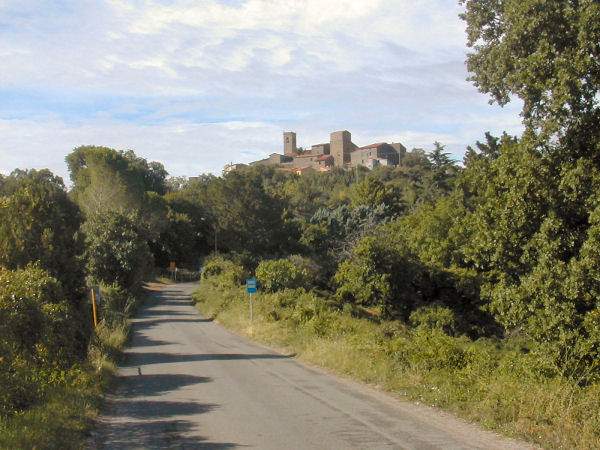A village of Etruscan origins, one of the main cities of southern Etruria, it declined in the Roman imperial period until it disappeared completely in the early Middle Ages, when the locality became known with the name of Colonna.
In the 19th century the archaeologist Isidoro Falchi brought to light the necropolis of the ancient city, and the original name of Vetulonia was reassigned to the village by royal decree of 22 July 1887.
The village rises 300 meters above sea level on the eastern foothills of the Poggio Ballone massif, overlooking the hill where the town of Buriano is located, dominating the plain of Grosseto to the west. Vetulonia is about 20 km from Grosseto and the municipal capital.
The territory of Vetulonia, from the Etruscan Vatluna, has been inhabited since the 9th century BC, in the Villanovan period, as evidenced by the discovery of some necropolises, but it was century BC, at the time of the maximum splendor of the Etruscan civilization, that the area became the site of the development of a more organized city. An important commercial center, over time it ended up competing with the nearby Roselle, founded on a hill beyond the plain, a little further east: the easier communications with the sea by means of the Ombrone river and the greater accessibility of the ports on Lake Prile , joined by a navigable channel with the Tyrrhenian Sea, made the trade go to the advantage of its rival. Until the 5th century BC. Vetulonia experienced a period of great economic prosperity, which was followed by a temporary crisis and a recovery during the 3rd century BC, a time in which the city minted its own currency, whose symbol, in which appears an anchor or dolphins or a trident , recalled the maritime origin of the city. Dionysius of Halicarnassus, Silio Italico, Pliny and Ptolemy give news of the city of Vetulonia.
Today Vetulonia is a small town visited by many tourists, especially in the summer months, due to the presence of many archaeological sites of the utmost importance: the site was discovered at the end of the 19th century century by the archaeologist Isidoro Falchi. It is characterized by the remains of the Hellenistic age town, located in Poggiarello Renzetti, along the municipal road, in Costa Murata and in Costia dei Lippi, near the modern cemetery and by the suggestive necropolises spread over the hills that surround the town. The most ancient well tombs of the Villanovan age, simple holes dug in the ground where to place the remains of the cremated inside biconical vases or hut-shaped urns , no longer recognizable within the thick Mediterranean maquis, have been progressively replaced by burial pits, often gathered within circles of stones stuck vertically into the ground, designed to delimit the members of the same family group. Among the circle tombs, sometimes still identifiable on the ground, we mention the Circle of Bes, the Circle of Jewelry, the Circle of the Trident, the two Circles of Furs, the Circle of Leoncini d’ Silver, the Tomb of the Lictor and the Tomb of the Duce.
Particularly interesting are, in the second half of the seventh century BC, the two monumental tombs, the Tomba della Pietrera and the Tomba del Diavolino, built in quadrangular chamber with false dome, accessible via a long corridor (dromos) and covered by a large mound of earth. The finds found in the Vetulonia necropolises are mainly kept in the national archaeological museum of Florence, in the Isidoro Falchi civic archaeological museum in Vetulonia and in the Maremma archaeological and art museum in Grosseto.
Mura dell’Arce, also called “Cyclopean walls”, were probably built in the Hellenistic age, proving that an urban center of a certain importance was located here. Of the walls only a few remains have been preserved, while in the historic center of the medieval village a section of it is preserved, in the northern part, near which the fortification of the castle of Colonna was erected.
Places of interest:
•Castello di Colonna, an imposing medieval fortress located in Vetulonia – known as Colonna – dates back to the 7th century as property of the bishops of Lucca. Given to the abbey of Sestinga, in the 13th century it was then owned by the Lambardi di Buriano and in 1331 it was conquered by the Sienese, who built a keep there. Substantially modified in the 15th century, it is now leaning against the houses of the village.
•Castello di Casallia, located downstream of the village, in the locality of Le Case, was built around the year one thousand as a convent dependent on the abbey of Sestinga. Transformed into a castle in the 13th century, it became the residence of various local lords. Substantially modified in the 16th century, it is now incorporated in a rural building, but the tower that was the former bell tower of the ancient structure is still recognizable.
In Vetulonia there is the Isidoro Falchi civic archaeological museum, an interesting Etruscan museum founded in 1969 and rearranged in 2000 inside the imposing building of the multi-purpose service center of the hamlet. The museum is included in the provincial Maremma Museums network.



